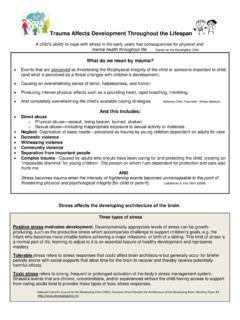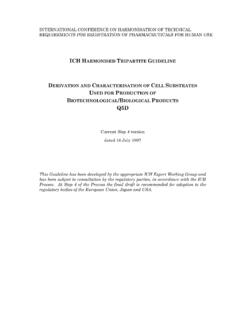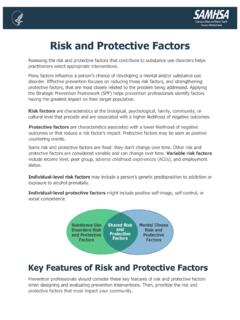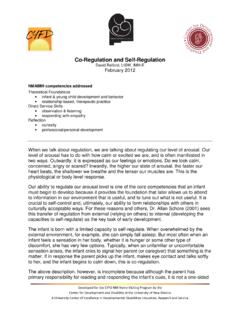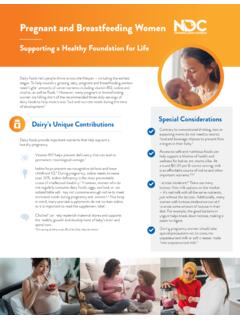Transcription of LIFE SPAN DEVELOPMENT
1 IDeveloped and Produced by the Teachers of Psychology in Secondary Schools (TOPSS) of the American Psychological Association, December 2012 life span DEVELOPMENTa six-unit lesson plan for high school psychology teachersSusan Krauss Whitbourne, PhD, University of Massachusetts, Amherstiv life span DeveLopmenta six-unit lesson plan for high school psychology teachersThis unit is a revision of the original TOPSS Unit Lesson Plan on DEVELOPMENT , originally prepared by Lynne Fellers, Nancy Grayson, Michael Sullivan, and Martha Whitacre and edited by Charles T. Blair-Broeker at the Texas A&M-NSF Summer Institute for the Teaching of AP and Honors Psychology in July unit is aligned to the following content standards of the National Standards for High School Psychology Curricula (APA, 2011):Standard Area: life span DevelopmentContent Standards:After concluding this unit, students understand:1.
2 Methods and issues in life span development2. Theories of life span development3. Prenatal DEVELOPMENT and the newborn4. Infancy ( , the first 2 years of life )5. Childhood6. Adolescence7. Adulthood and agingThe APA Committee of Teachers of Psychology in Secondary Schools (TOPSS) thanks Deborah Caudell, Fred Connington, Matt Heling, Amy Johnson, Kathy Neely, James Stancil, Laura Vrba-Carrick, Ellen Zwarensteyn, and Will Elmhorst for their work on a previous draft revision of this unit lesson plan, along with Laura Berk, PhD, of Illinois State University, for her review and feedback in 2007. TOPSS also thanks James P. Buchanan, PhD, of the University of Scranton (Scranton, PA), Michael Hamilton of Hopkinton High School (Hopkinton, MA), and Sachi Horback, PsyD, of Colby-Sawyer College (New London, NH) for their reviews of and contributions to this unit plan.
3 V contents 1 Procedural Timeline 3 Introduction 5 Content Outline31 Activities 47 References and Resources 53 Discussion QuestionsThis project was supported by a grant from the American Psychological 2012 American Psychological timelineprocedural outlineLesson 1: Methods and Issues in life span DEVELOPMENT Activity : Introductory Survey and Content DiscussionActivity : Nature and Nurture in DevelopmentLesson 2: Theories of life span DevelopmentLesson 3: Prenatal DEVELOPMENT and the NewbornLesson 4: Infancy and ChildhoodActivity 4: Early Motor and Verbal DevelopmentLesson 5: Adolescence and Emerging AdulthoodActivity 5: Three Tasks of Adolescent Identity: Cognitive, Moral, and SocialLesson 6: Adulthood and AgingActivity 6: Bridging the Generation Gap: Interviewing a Senior Citizen About Adolescence3 Developmental psychology is increasingly becoming a psychology of the life span rather than being limited to the psychology of infancy to adolescence.
4 The goal of this unit plan is to present ideas that will help teachers provide students with a broad-based, contemporary view of the field that will also give them an excellent grasp of both the conceptual issues and practical applications of knowledge about change over the life can easily relate to many of the topics covered in this unit. Obviously, they can reflect on their own developmental changes from childhood through adolescence, but they also can relate the material to changes among their families and friends. The content in this unit could be of great help to students as they plan their futures. Themes such as health, identity, relationships, parenting, education, and work have universal significance. With the growing focus on diversity in the field of human DEVELOPMENT , the topic also provides an excellent way to incorporate insights from research on cultural, ethnic, geographical, and socioeconomic diversity.
5 Developmental psychology is increasingly taking a contextual approach that places great importance on many types of variations in human growth and , as students prepare for future careers, they will benefit from learning in particular about the field of adult DEVELOPMENT and aging. Adults age 65 and older constitute the fastest-growing segment of the population, and in many parts of the world, the growth will continue at far more disproportionate rates compared to other age groups in the topic of life span DEVELOPMENT also presents valuable opportunities for instruction in the area of research methods. Because age is not a true independent variable, it is not possible to conduct experimental studies. Learning how researchers attempt to overcome this challenge presents interesting ways to engage students critical thinking abilities.
6 Related to this point is the fact that the age of the individual is confounded with the historical period in which the individual grows older. The so-called cohort and time of measurement introduction4effects that can appear to be changes due to age cannot be entirely ruled out when examining any study on life span DEVELOPMENT . There are designs that make it possible to evaluate the impact of these factors, but cohort and time of measurement effects can never be entirely eliminated. Many studies using the cross-sectional method (in which participants from different age groups are compared at one point in time) fail to control for between-cohort differences. Encouraging students to question the results of these studies provides valuable lessons in evaluating research evidence in psychology. You can also use the material in this unit to emphasize the role of biology in behavior.
7 Changes in each system of the body interact in important ways with psychological changes in areas such as cognition, emotions, and identity. In addition, the nature nurture issue presents numerous complexities regarding the interaction between genetic and environmental influences on DEVELOPMENT . Research emerging in recent years is showing increasingly that it s not just a matter of nature and nurture as joint influences on the individual, but that nurture can also influence nature. Discussion of these complexities can introduce students to an important emerging area of research and at the same time can stimulate students to think about one of the great philosophical issues in psychology that of free will versus , students can benefit from examining the material on later adulthood from the point of view of stereotypical views of aging, also known as ageism.
8 Once sensitized to this issue, students can be asked to bring in situations from fiction and everyday life that exemplify these attitudes. Encouraging them to challenge these stereotypes will foster the DEVELOPMENT of important sensitivities that will help them in relationships with their families and their work a practical matter, you need to decide whether to cover DEVELOPMENT from the topical or chronological perspective. This decision will most likely be determined by the textbook your school adopts. In general, though, the topical approach has the advantage of emphasizing continuity rather than dividing the life span into discrete units, but students find it easier to relate to the chronological approach. You can split the difference somewhat, however, by emphasizing continuity within the chronological approach and by teaching about theories of DEVELOPMENT with an emphasis not on stages but on the principles of the theories themselves.
9 The majority of developmental theories are not as strictly age based as many people think. As you ll learn, Erikson, Piaget, and Kohlberg, perhaps the three most influential developmental theorists, believed that the ages associated with the stages were 1: METHODS AND ISSUES IN life span DEVELOPMENTIn this lesson, you will introduce students to the general issues that developmental psychologists examine and how they collect their data. See Activity Introductory Survey and Content Discussion (In Activities section)I. Nature and nurture in DEVELOPMENT : DEVELOPMENT is influenced by both nature, or heredity, and nurture, or the environment. A. Although each individual inherits a specific pattern of genes from his or her parents, the expression of those genes is influenced by the environment in which the individual grows.
10 B. It no longer is a case of nature versus nurture because researchers understand that both play a role in influencing the changes throughout life . C. Furthermore, specific environmental factors can influence the expression of genes. ExAMPLE Maternal stress may alter the genetic material of her fetus. Similarly, in later adulthood, an individual may have a genetic risk for developing Alzheimer s but not be afflicted by the disorder if he or she is intellectually or physically Activity : Nature and Nurture in DEVELOPMENT (in Activities section) D. The nature nurture discussion deals with the extent to which heredity content outlinecontent outline6and the environment influence our behavior. Behavioral genetics studies the role played by inheritance in mental ability, temperament, emotional stability, and so on.










